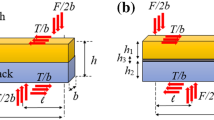Abstract
The interfacial crack initiation characteristics of bimaterial and sandwich strip blister specimens were compared. Interface cracks were grown along glass/epoxy interfaces and the corresponding loads, normal crack opening displacements (NCOD) and crack front geometries were measured. Finite element analyses were used to compare NCOD, extract fracture parameters and examine near front stress fields. On the small scale of crack extension that could be measured, the bimaterial specimens exhibited resistance curve behavior whereas none could be resolved in the sandwich specimens. The phase angle dependence of toughness in the bimaterial specimens was similar to that obtained in previous blister tests but was much steeper than has otherwise been measured. The toughness of the glass/epoxy interface in the sandwich specimen decreased with decreasing epoxy thickness in spite of the fact that it was never completely spanned by plastic zones.
Similar content being viewed by others
References
W.D.Bascom, R.L.Cottington, R.L.Jones and P.Peyser, Journal of Applied Polymer Science 19 (1975) 2545–2562.
D.L.Hunston, J.L.Bitner, J.L.Rushford, J.Oroshnik and W.S.Rose, Journal of Elastomers and Plastics 12 (1980) 133–149.
A.J.Kinloch and S.J.Shaw, Journal of Adhesion 12 (1981) 59–77.
H. Chai, in Composite Materials: Testing and Design (Seventh Conference), ASTM STP 893 (1986) 209–231.
H.Chai, Engineering Fracture Mechanics 24 (1986) 413–431.
H.Chai, International Journal of Fracture 37 (1988) 137–159.
W.A.Zdaniewski, J.C.ConwayJr. and H.P.Kirchner, Journal of the American Ceramics Society 70 (1987) 110–118.
S.S.Wang, J. F.Mandell and F.J.McGarry, International Journal of Fracture 14 (1978) 39–58.
J.H. Crews, Jr., K.N. Shivakumar and I.S. Raju, in Adhesively Bonded Joints: Testing Analysis and Design, ASTM STP 981 (1988) 119–132.
P.D. Mangalgiri, W.S. Johnson, and R.A. Everett, Jr., in Adhesion International (1987) 725–750.
N.A.Fleck, J.W.Hutchinson and Z.Suo, International Journal of Solids and Structures 27 (1991) 1683–1703.
J.M. Scott and D.C. Phillips, Journal of Materials Science (1975) 551–562.
Z.Suo and J.W.Hutchinson, Materials Science and Engineering A107 (1989) 135–143.
J.S.Wang and Z.Suo, Acta Metallurgica 38 (1990) 1279–1290.
L.G. Rosenfeld, J.E. Ritter, T.J. Lardner and M.R. Lin, Journal of Applied Physics, in press.
K.M.Liechti and W.G.Knauss, Experimental Mechanics 22 (1982) 383–391.
K.M.Liehti and E.C.Hanson, International Journal of Fracture 36 (1988) 199–217.
K.M. Liechti and Y-S. Chai, Journal of Applied Mechanics, in press.
Y-M. Liang, The Effect of Elastic Constraint on the Interfacial Toughness of Layered Media, Report EMRL 89/5, Engineering Mechanics Research Laboratories, The University of Texas at Austin (1989).
E.B. Becker, R.S. Chambers, L.R. Collins, K.M. Liechti, W.G. Knauss and R. Romanko, Viscoelastic Stress Analysis Including Moisture Diffusion for Adhesively Bonded Joints, AFWAL-TR-84–4057.
M.Stern, International Journal for Numerical Methods in Engineering 14 (1979) 409–420.
J.F.Fau and S.S.Wang, Engineering Fracture Mechanics 20 (1984) 423–432.
K.Arin and F.Erdogan, International Journal of Engineering Science 9 (1971) 213–232.
M.S. Dadkhah, A.S. Kobayashi and W. L. Morris, in The 22nd Fracture Mechanics Symposium, ASTM STP (1991) in press.
C.F. Shih, Private communication.
E.Zywicz and D.M.Parks, International Journal of Fracture 42 (1990) 129–143.
A.G.Evans and J.Hutchinson, Acta Metallurgica 37 (1989) 909–916.
H.M.Jensen, J.W.Hutchinson and K-S.Kim, International Journal of Solids and Structures 26 (1990) 1099–1114.
H.Chai, International Journal of Fracture 46 (1990) 237–256.
K.N.Shivakumar and J.H.CrewsJr., Engineering Fracture Mechanics 28 (1987) 319–330.
H.C.Cao and A.G.Evans, Mechanics of Materials 7 (1989) 295–304.
K-S.Kim and N.Aravas, International Journal of Solids and Structures 24 (1988) 417–435.
Author information
Authors and Affiliations
Rights and permissions
About this article
Cite this article
Liechti, K.M., Liang, Y.M. The interfacial fracture characteristics of bimaterial and sandwich blister specimens. Int J Fract 55, 95–114 (1992). https://doi.org/10.1007/BF00017271
Received:
Accepted:
Issue Date:
DOI: https://doi.org/10.1007/BF00017271




